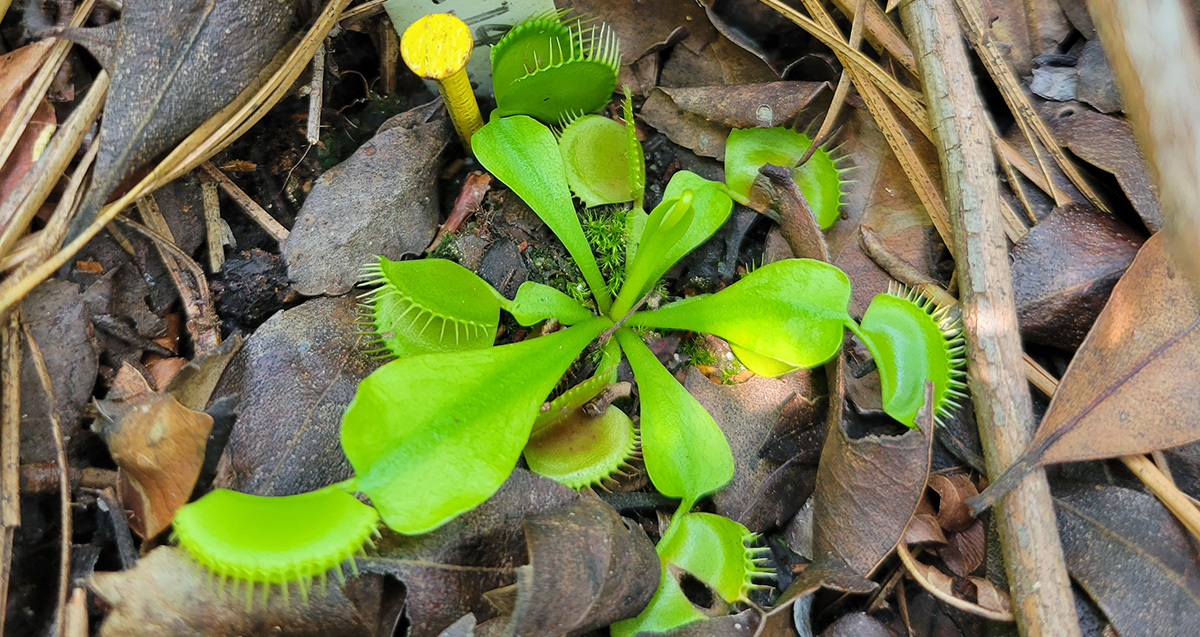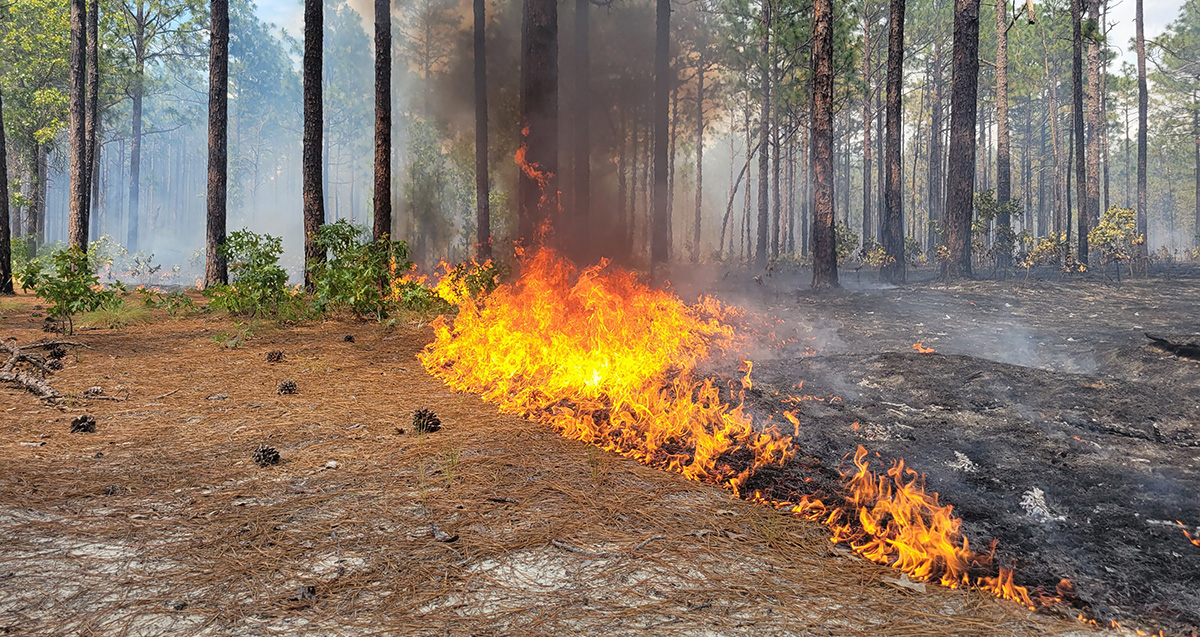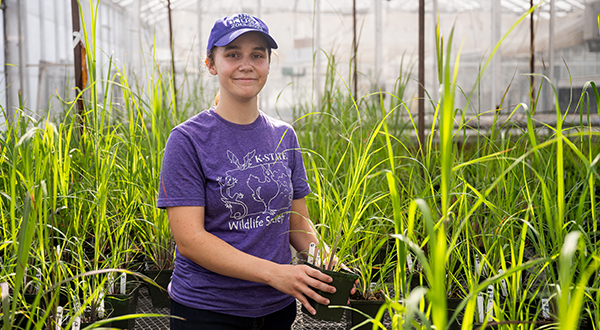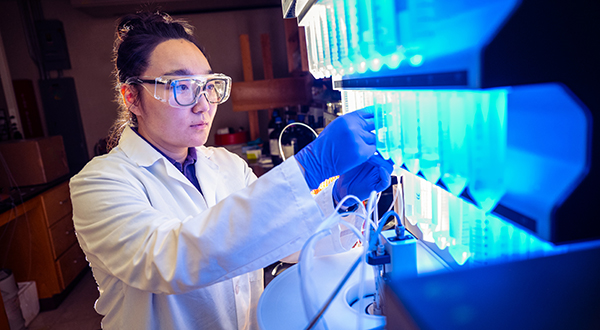The charismatic partner of a K-State researcher
K-State researchers are exploring the relationship between fire and Venus flytrap populations.
 Researchers are analyzing how fire history influences the rare carnivorous plant's current and future population trends. | Download this photo.
Researchers are analyzing how fire history influences the rare carnivorous plant's current and future population trends. | Download this photo.
 By Emily Boragine
By Emily Boragine
K‑State News and Communications Services
Wednesday, March 12, 2025
MANHATTAN — Allison Louthan will never forget the first time the Venus flytrap caught hold of her.
“I felt like I could help save a species,” said Louthan, assistant professor in the College of Arts and Sciences' Division of Biology. “People care about Venus flytraps and want to see them survive. It can be pretty galvanizing for people in a way that other plants and animals may not be.”
K-State researchers are exploring the critical relationship between fire and Venus flytrap populations, with implications for conservation biology and climate science.
A decade of discovery
Louthan’s work with Venus flytraps began when she was a postdoctoral researcher and has now evolved into a collaborative effort with Duke University that she shares with K-State students. Building on a decade of data collection, researchers are analyzing how fire history influences the rare carnivorous plant's current and future population trends.
While fire is a critical disturbance that maintains Venus flytrap population density, the effects of climate variability on this relationship are poorly understood. Longer or more intense droughts can potentially hinder population recovery after fires.

A data-driven approach
Using data from Venus flytrap populations marked as far back as 2015, Louthan’s team studies whether climate conditions—such as hotter, drier weather or cooler, wetter conditions—affect plant survival and reproduction following fires. This research will help determine if Venus flytraps can serve as indicator species, predicting broader ecological changes driven by fire and climate variability.
Zheng Yao, a graduate student in biology, has been an active part of the project since his admission to K-State in fall 2024. He was drawn in by the project’s focus on plant ecology and its use of advanced analytical techniques.
“I wanted to work on this project because it involves an interesting target species and allows me to develop skills in data integration, analysis and experimental design,” Yao said. Yao is currently working with Louthan to examine the legacy effects of fire suppression on Venus flytrap populations.
A second study in development will take the research a step further by using controlled environmental conditions to assess how burning regimes influence Venus flytrap performance.
Tomorrow’s ecologists
The project provides a unique training opportunity for graduate and undergraduate students in ecology and conservation. Maddie Baucom, K-State biology student, started working in Louthan’s lab in the summer of 2023 on a Konza Prairie research project. When Baucom asked Louthan if her lab had space for her senior thesis, Louthan was more than happy to welcome her.
Working on the Venus flytrap research gives Baucom research skills that can be immediately applied after graduation. Some of Baucom’s responsibilities involve data entry, data analysis and question formulation. Baucom and other undergraduate students on the project construct equipment needed for fieldwork and tackle the substantial task of entering and cleaning data.
“We want to help students build skills that allow them to achieve their goals, whether that is research, management, or simply learning more about the world around them,” said Louthan.
By participating in the Venus flytrap research, Baucom is achieving her goal of becoming more involved in data curation an analysis. In addition to the technical skills she’s learning, she will have publishable work that can enhance her post-graduation resume.
An eye on the future
Louthan and her team regularly focus on how species interactions and climate variability influence plant population dynamics and distribution patterns. By combining observational fieldwork, experiments and modeling to study the impacts on future biodiversity, Louthan's team is assembling a comprehensive ecological picture.
Yao is investigating how fire suppression has led to long-term shifts in Venus flytrap populations. By integrating historical data with current observations, he hopes to identify trends that can inform future land management strategies.
“Our findings will have broader implications beyond the Venus flytrap,” Yao said. “Understanding how plants respond to fire and climate variability will help us predict ecological changes in other fire-prone ecosystems.”
With each year of added data, the researchers gain additional power to detect if colder, wetter conditions or hotter, drier conditions influence survival or reproduction. Without these long-term data, Louthan could not accurately estimate the effects of environmental conditions on population dynamics, limiting her ability to predict how Venus flytrap population densities will change in the future.
“We will keep doing this research for as long as we can,” Louthan said.
###
Get K-State news in your inbox
Subscribe to receive K-State news directly to your inbox every Monday.


